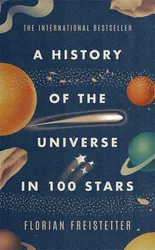A History of the Universe in 100 Stars by Florian Freistetter takes the form of 100 short chapters, each with the title of a star. Most of these are real stars that actually exist in the universe somewhere, although many are not actually stars, for example the so-called morning star which is really the planet Venus. The fact that we get many different types of astronomical object adds a lot more variety to the book, as it covers supernovae, black holes, comets, galaxies and several other astronomical phenomena, rather than just stars.
Since many of the stars we know about haven’t been given memorable names, a lot of the chapters are titled with catalogue numbers, like TYC 278-748-1, which makes it a little hard to flip back through looking for specific chapters, as I have just done in preparing this review!
Each chapter aims to give us an interesting perspective on astronomy and what’s special about that chapter’s star. I wouldn’t say that the book really provides a history of the universe, as the title suggests it might. The chapters aren’t in any kind of order in terms of the age of the objects they are describing, or even in the order in which the discoveries were made. Instead of a chronological history, we do get a lot of interesting facts and anecdotes about the things astronomers have learned about the universe by observing the stars, and the characters who have done that observing.
I was suprised to learn that most stars in our galaxy form part of a binary star system, and that our own sun is unusual in being a solitary star. In the chapter ‘Nemesis’, the search for a hypothetical partner star to the sun is described. The theory is based on the idea that there may have been mass extinctions on earth approximately every 26 million years, and that there could be a star that approaches close enough every 26 million years to disturb a few asteroids that collide with Earth, causing these extinctions. However, so far such a star has not been found, and the proposed 26 million year cycle of extinctions is doubtful as well. I found it interesting that there is such a variation of brightness of stars, so that a dim star could be lurking in relatively close proximity to us without us noticing it.
Although none of the chapters go into a huge amount of detail, they are all good jumping off points for futher reading and study, and there is a good ‘further reading’ section at the back of the book (one of the books listed, by sheer coincidence, is the next book I’ll be reviewing: The 4% Universe). One thing this book conveys really well is how much we don’t know about our galaxy, and the galaxies beyond, and I found myself caught up in the author’s enthusiasm for space and the stars while reading this book.
Some Errors I Noticed
The book was originally written in German. The English translation seemed fine to me; it was easy to read with no obvious clunky sentences. I did notice a couple of mistakes though. I'm not sure if these were present in the original book or were introduced during translation.
- On P229 in my copy, in the chapter 'SO-102', it says that a black hole has the mass of 4.1 Suns, when elsewhere in the book black holes are stated to have several million times the mass of the sun, so I believe this should be '4.1 million suns'.
- On P234 in my copy, in the chapter 'Scholz's Star', the book states that Earth is 0.8 light years from the sun, when in fact we are 8.3 light minutes away (much closer!). I think the confusion here is that they are talking about Scholz's star making its closest approach to the sun at a distance of 52,000 astronomical units, which is 0.8 light years, and comparing this to the distance of the Earth from the Sun, which is (by definition) 1 astronomical unit, or 0.00001581256 light years.
In a book that relies on huge numbers to convey a sense of wonder for the scale of the universe, these are sloppy errors. I was reading the hardback edition from 2021 so hopefully these errors have been corrected in later prints!
